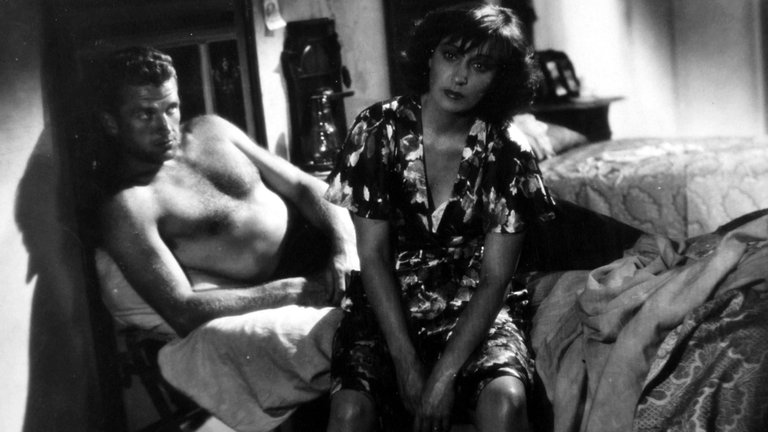
Italian Neorealism, movement primarily associated with the Italian film industry in the first decade after World War II, has been recognised by critics, film scholars, and connoisseurs to have roots in the earlier period as well. One of the prime candidates for the title of the first Italian neorealist film is the 1943 drama Obsession, better known under its original Italian title Ossessione. This film is notable for being the directorial debut of the renowned Luchino Visconti and holds an important place in the history of film noir, albeit in an unconventional manner.
The film is based on James M. Cain's 1934 novel The Postman Always Rings Twice, which was been adapted by Hollywood twice – as 1946 film noir classic and as its 1981 remake. However, the novel also held great appeal for European filmmakers, and its first adaptation was made in France in 1939 under the title The Last Turning. Visconti faced a significant challenge in adapting the novel for the screen, as Italy and the United States were at war, making it impossible to obtain the necessary film rights. Undeterred, Visconti, just like Goffredo Alessandrini with his adaptation of Ayn Rand’s novel We the Living one year earlier, decided to disregard legal niceties and proceed with the project, while also altering the setting and plot of the novel to create a unique adaptation.
The film is set somewhere in the Po Valley, where penniless but handsome drifter Gino Costa (played by Masimo Girotti) tries to get food and shelter at a rural tavern and petrol station owned by Giuseppe Bragana (played by Juan De Landa). Gino's plan to do so without payment is thwarted when he notices Giuseppe's young and attractive wife Giovanna (played by Clara Calamai), leading to a passionate sexual liaison. Gino decides to stay at the inn and provide menial labor as a pretext to continue the adulterous affair in the presence of her unsuspecting husband. However, Gino soon becomes restless and suggests that Giovanna leave Giuseppe and join him on the road. When she refuses, he leaves without her, but a chance encounter with the Braganas at a singing contest in Ancona rekindles their old passion. Acting on impulse, the lovers decide to get rid of Giuseppe by using his drunkenness and staging a fatal traffic accident. Giovanna inherits money and brings Gino to the tavern, but gossiping neighbours, ongoing police investigation, and feelings of guilt begin to make life miserable for the murderous couple.
The neorealist credentials of the film are evident in its setting, which covers rather unglamorous sections of rural Italy and deals with people at the bottom or lower levels of social strata in a realistic way, far from Hollywood-like glitz and glamour. Visconti's style, based on wide and medium shots, is used to immerse the audience in the surroundings, and actual locations are used with close-ups only briefly employed in more emotional scenes.
While later neorealist films used non-professional actors, Visconti has cast two big stars of early 1940s Italian cinema in the main roles: Massimo Girotti and Clara Calamai. Girotti's portrayal of Gino, with his handsome looks at odds with his cheap, washed-up clothing, convincingly suggests that this is the result of his personal choice and conscious acceptance of a nomadic lifestyle rather than economic woes. Calamai, the grand diva of Italian cinema, is great as the irresistible yet ordinary woman, straying away from femme fatale stereotypes of film noir. Spanish actor Juan de Landa is even better in the role of the physically unattractive husband whose plight the audience slowly builds sympathy for.
Visconti also gave the film a personal touch by expanding the theme of the conflict between freedom and domesticity encapsulated in the troubled relationship between Gino and Giovanna. He did this by introducing new characters that offer alternatives to Gino. First is a traveling salesman and fellow vagabond Lo Spagnolo ("Spaniard"), played by Elio Marcuzzo, who advises him to run away from Giovanna and keep his freedom. Those who like to seek hidden context in old films might easily consider Lo Spagnolo as a homosexual whose unrequited love to Gino plays a part in the melodramatic resolution of the plot. Another character is a young prostitute Anita, played by Dhia Cristiani, who is as easily seduced as Giovanna but provides the sexual service to Gino without emotional and romantic baggagege.
Made during the war, any references to those events were carefully removed from Ossessione. The sexual content and immorality of the characters, despite being rather tame even for 1940s Italian standards, brought the ire of the Catholic Church, whose priests exorcised some of the theatres showing the film. This further brought hostility from the fascist regime, which, following the establishment of the Italian Social Republic in German-occupied northen part of Italy, formally banned the film and ordered the destruction of all copies. Visconti managed to preserve one negative, which allowed the film to be shown after the war, although its distribution in the United States, due to copyright issues, would have to wait until 1976.
Taken without its historic context, Ossessione is a very good film, superbly directed and well-acted, but still far from perfect. Visconti's directorial style and black-and-white cinematography are at times rough around the deges, and the music score by Giuseppe Rosatti is too melodramatic and shows the film's age. As a result, Ossessione suffers in comparisons with latter adaptations of Cain's novel, as well as other classics of the Neorealist movement.
Despite these flaws, the lofty position of Ossessione as a classic of Italian and world cinema is quite justified. It is a landmark film that showcases Visconti's unique blend of neorealism and film noir, and its influence can be seen in many later films.
RATING: 7/10 (+++)
Blog in Croatian https://draxblog.com
Blog in English https://draxreview.wordpress.com/
InLeo blog https://inleo.io/@drax.leo
Hiveonboard: https://hiveonboard.com?ref=drax
Rising Star game: https://www.risingstargame.com?referrer=drax
1Inch: https://1inch.exchange/#/r/0x83823d8CCB74F828148258BB4457642124b1328e
BTC donations: 1EWxiMiP6iiG9rger3NuUSd6HByaxQWafG
ETH donations: 0xB305F144323b99e6f8b1d66f5D7DE78B498C32A7
BCH donations: qpvxw0jax79lhmvlgcldkzpqanf03r9cjv8y6gtmk9
Posted Using InLeo Alpha